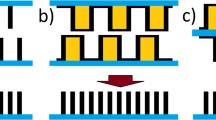Abstract
In this contribution we discuss the possibility of designing a modified transmission X-ray microscope by using fractal zone plates (Fzps) as diffractive optical elements. In the modified transmission X-ray microscope optical layout, we first introduced a fractal zone plate as the microscope objective. Indeed, a fractal zone plate cannot only be used as an image-forming component but also as a condenser element to achieve an extended depth of field. Numerical analysis reveals that fractal zone plates and conventional Fresnel zone plates have similar imaging capabilities under different coherent illumination. Using a fractal zone plate as a condenser we also simulated axial irradiance. Results confirm that fractal zone plates can improve focusing capability with an extended depth of field. Although preliminary, these simulations clearly reveal that fractal zone plates, when available, will be of great help in microscope layouts, in particular for foreseen high-resolution applications in the “water window” as strongly required in biological research.





Similar content being viewed by others
References
Schneider G (1998) Ultramicroscopy 75:85–104
Thieme J, McNulty I, Vogt S, Paterson D (2007) Environ Sci Technol 41:6885–6889
Andrews JC et al (2010) Microsc Microanal 16:327–336
Meyer-Ilse W et al (2001) J Microsc 201:395–403
Larabell CA, LeGros MA (2003) Mol Biol Cell 15:957–962
Myneni SCB, Brown JT, Martinez GA, Meyer-Ilse W (1999) Science 286:1335–1337
Stoll H et al (2004) Appl Phys Lett 84:3328–3330
Chen J et al (2010) Anal Bioanal Chem 397:2117–2121
Snigirev A, Kohn V, Snigireva I, Souvorov A, Lengeler B (1998) Appl Opt 37:653–662
Takeuchi A, Suzuki Y, Takano H, Terada Y (2005) Rev Sci Instrum 76:093708–093708
Kumakhov MA (1999) X-ray Spectrom 29:343–348
Yun W et al (1999) Rev Sci Instrum 70:2238–2241
Fabrizio ED, Romanato F, Gentili M, Cabrini S, Kaulich B, Susini J, Barrett R (1999) Nature 401:895–898
Chao W, Harteneck BD, Liddle JA, Anderson EH, Attwood DT (2005) Nature 435:1210–1213
Chao W, Anderson EH, Fischer P, Kim DH (2008) SPIE 6683:88309–88309
Furlan WD, Saavedra G, Monsoriu JA (2007) Opt Lett 32:2109–2111
Tao SH, Yuan XC, Lin J, Burge RE (2006) Appl Phys Lett 89:31105–31107
Monsoriu JA, Zapata-Rodríguez CJ, Furlan WD (2006) Opt Commun 263:1–5
Monsoriu JA, Furlan WD, Andrés P, Lancis J (2006) Opt Express 14:9077–9082
Giménez F, Monsoriu JA, Furlan WD, Pons A (2006) Opt Express 14:11958–11963
Saavedra G, Furlan WD, Monsoriu JA (2003) Opt Lett 28:971–973
Rodrigo JA, Alieva T, Calvo ML, Davis JA (2005) J Mod Opt 52:2771–2783
Born M, Wolf E (1980) Principles of optics. Cambridge University Press, Cambridge
von Hofsten O, Takman PAC, Vogt U (2007) Ultramicroscopy 107:604–609
Wu D, Niu LG, Chen QD, Wang R, Sun HB (2008) Opt Lett 33:2913–2915
Acknowledgments
We would like to gratefully acknowledge Augusto Marcelli for many fruitful discussions. This work was partly supported by the National Basic Research Program of China (2009CB930804, 2012CB825800), the Knowledge Innovation Program of the Chinese Academy of Sciences (KJCX2-YW-N42), the Key Important Project of the National Natural Science Foundation of China (10734070), the National Natural Science Foundation of China (11179004, 10979055), the Fundamental Research Funds for the Central Universities (WK2310000008, WK2310000021) and the China Postdoctoral Science Foundation (2011M501064).
Author information
Authors and Affiliations
Corresponding authors
Additional information
Published in the special paper collection Imaging Techniques with Synchrotron Radiation with guest editor Cyril Petibois.
Rights and permissions
About this article
Cite this article
Ge, X., Wang, Z., Gao, K. et al. Use of fractal zone plates for transmission X-ray microscopy. Anal Bioanal Chem 404, 1303–1309 (2012). https://doi.org/10.1007/s00216-012-6126-0
Received:
Revised:
Accepted:
Published:
Issue Date:
DOI: https://doi.org/10.1007/s00216-012-6126-0




